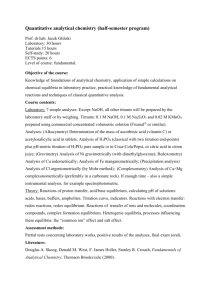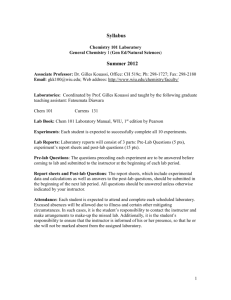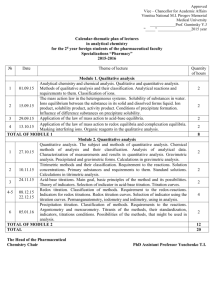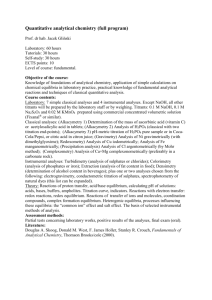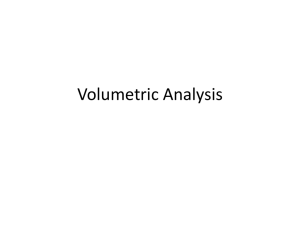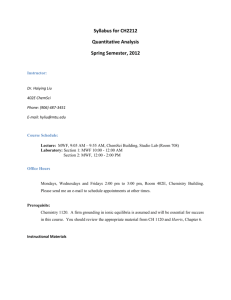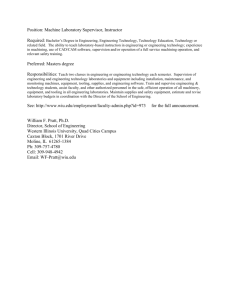Chemistry: 341 Analytical Techniques
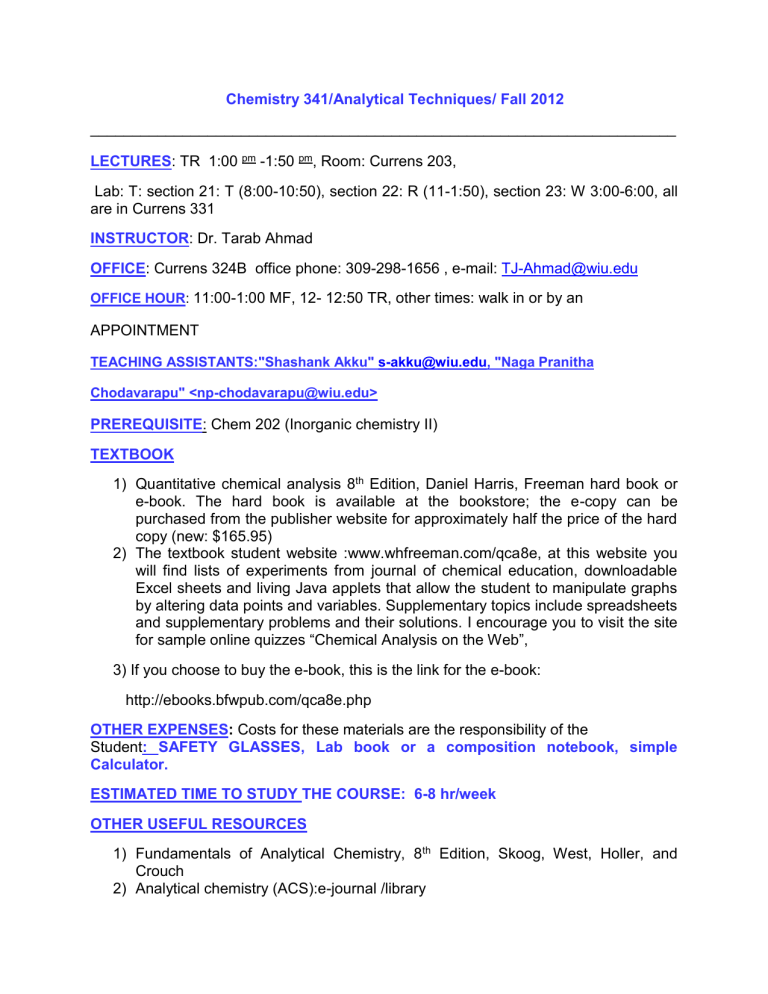
Chemistry 341/Analytical Techniques/ Fall 2012
______________________________________________________________________
LECTURES : TR 1:00 pm -1:50 pm , Room: Currens 203,
Lab: T: section 21: T (8:00-10:50), section 22: R (11-1:50), section 23: W 3:00-6:00, all are in Currens 331
INSTRUCTOR : Dr. Tarab Ahmad
OFFICE : Currens 324B office phone: 309-298-1656 , e-mail: TJ-Ahmad@wiu.edu
OFFICE HOUR : 11:00-1:00 MF, 12- 12:50 TR, other times: walk in or by an
APPOINTMENT
TEACHING ASSISTANTS:"Shashank Akku" s-akku@wiu.edu
, "Naga Pranitha
Chodavarapu" <np-chodavarapu@wiu.edu>
PREREQUISITE : Chem 202 (Inorganic chemistry II)
TEXTBOOK
1) Quantitative chemical analysis 8 th Edition, Daniel Harris, Freeman hard book or e-book. The hard book is available at the bookstore; the e-copy can be purchased from the publisher website for approximately half the price of the hard copy (new: $165.95)
2) The textbook student website :www.whfreeman.com/qca8e, at this website you will find lists of experiments from journal of chemical education, downloadable
Excel sheets and living Java applets that allow the student to manipulate graphs by altering data points and variables. Supplementary topics include spreadsheets and supplementary problems and their solutions. I encourage you to visit the site for sample online quizzes “Chemical Analysis on the Web”,
3) If you choose to buy the e-book, this is the link for the e-book:
http://ebooks.bfwpub.com/qca8e.php
OTHER EXPENSES : Costs for these materials are the responsibility of the
Student : SAFETY GLASSES, Lab book or a composition notebook, simple
Calculator.
ESTIMATED TIME TO STUDY THE COURSE: 6-8 hr/week
OTHER USEFUL RESOURCES
1) Fundamentals of Analytical Chemistry, 8 th Edition, Skoog, West, Holler, and
Crouch
2) Analytical chemistry (ACS):e-journal /library
3) National institute of standards and technology NIST website
4) J. Chromatography A
5) LCGC north America, www.chromatographyonline.com
6) Spectroscopy magazine
7) Analytical abstracts e-journals/library
8) J. chemical education
OVERVIEW OF SCHEDULE AND COVERAGE.
(Note:Chaps.0&2 your responsibility, read chapters 1 and 2 before you come to the first lab)
Section I : Tools for analytical chemistry
Section II : Aqueous Equilibria, Titrimetric methods,
Acid base and Complexometric Titrations
Section III : Redox and Electrochemical methods
Section IV : Spectrochemical Methods
Section V : Separations
This course will focus on quantitative analytical techniques (ch0-15). These chapters will discuss analytical chemistry tools like statistics, sources of errors and how to avoid them, quality assurance, aqueous equilibria and different types of titrations. A limited number of instrumental techniques will be covered in this course ( in the lab
(spectrophotmetric determination of iron, TLC or HPLC) and in the lecture if time allows. The instrumental techniques will be covered in chem 442 which is offered usually in the Spring and which is a requirement for chem and Forensic chem majors but not for other disciplines. Therefore, the few instrumental methods that will be taught in this course will serve as a background for anyone who will use these techniques in the future.
Tentative
Content
Course
Tools for analytical
Chem
Chapter 1, 3, 4, 5
Tests, HWs
Aqueous Equilibria
Chapter 6-8
Acid-base,
Complexometric
Titrations
Chapter 10-11
HW1
HW2
TEST I (Mid Sep)
HW2
HW3
TEST II (Mid Oct
HW4
HW5
Redox&
Electrochemistry
HW6
HW7
Chapter 13-15
Spectroscopy
Chapters 20
Separations
Chapters 23-25
Gravimetric analysis and precipitation titrations
Monday, Dec 12
Comprehensive FINAL
EXAM or ACS exam,
Thursday, Dec 11,
1:00 am -2:00
TEST III(Mid Nov)
HW8
HW9
HW10
Test IV(Early
December)
Will be covered in the lab in two experiments
GRADING: There will be four exams ( 300 points ) and one exam will be dropped. There will be a final exam ( 100 points ) which is an analytical ACS exam and it will cover all the material given in chem. 341. There will be 5-10 take home assignments (HW) at the end of each chapter ( 100 points ) and 710 QUIZZES ON MONDAYS (100 points).
Few quizzes and few HW assignments will be dropped from the total grade for quizzes and assignments. The total grade for the tests, HW and quizzes without the lab grades is 600 points . Your Final Examination and your quizzes scores MAY NOT BE
DROPPED and must be included in your final point total.
Twelve laboratory exercises are planned for this semester. Only your ten best laboratory exercises will be counted toward your final grade. The labs will be worth a total of 400 points . You must score a minimum of 78 % or 312 points in the laboratory exercises to pass Chem341.
Activity
4Exams
Assignments(best 8)
Quizzes (best of 5 quizzes)
Labs
Final (ACS)Exam
Total
300
100
100
400
100
1000
COURSE GRADING SCALE
The following scale will be used to assign an overall grade for this class:
%
93-100%
88 - 92%
85 - 87%
82 - 84%
78- 81%
75-77
72-74%
68-71%
C
C-
65-67 D+
62-64 D
58-61 D-
Grade
A
A-
B+
B
B-
C+
TEST POLICY
I n order to accommodate illness and /or other excused absences the comprehensive make up exam will be given at the end of the semester. You may use this to make up one, and only one, missed examination. The time and date for the make-up exam for all missed exams will be announced in November. The make-up exam will be comprehensive over all materials covered in chem. 341. Students who miss more than one exam should drop the course.
No make-up quizzes, home work, or laboratory exercises will be given. Your two lowest lab grade will be dropped and a few low quiz scores will be dropped. Missing more than one exam ; having fewer than the required number of quizzes or home work assignments; or missing three laboratory exercises will ensure a zero will be incorporated into your final grade.
DO NOT MISS MORE THAN THE ALLOWED NUMBER
Exceptions to the above rules will only be made for University sponsored functions that require your presence during the class period (i.e. WIU band trips, field trips in other
WIU classes, WIU athletics, etc.), and military commitment. Notification of the official
WIU sponsored function, in the form of a signed memo from the faculty sponsor or coach, must be submitted to the instructor at least 7 days prior to the expected absence. Evidence of military commitment should be presented as soon as possible.
LECTURE NOTES , QUIZZES, HOMEWORK
All materials related to the course including lecture notes, homeworks will be posted on the western online
LAB POLICY
The lab syllabus will be separate from the course syllabus. For lab instructions read the information posted on westernonline in the lab folder. Information will be posted weekly.
ATTENDANCE POLICY: You are expected to attend class regularly and punctually.
You are responsible for all information and materials in sessions and classes whether you are present or not. Any student who receives six or more absences may be dropped from this course without notice. Any student arriving more than ten minutes late for any exam, laboratory exercise, or the final examination may not be allowed to take or complete the assigned work at the instructor’s discretion. Any student attempting to turn in a home work assignment more than ten minutes late may not be allowed to turn in the assigned work at the instructor’s discretion. Leaving the classroom prior to completion of a quiz or an exam is prohibited.
STATEMENT ON ETHICS
Western Illinois University, like all communities, functions best when its members treat one another with honesty, fairness, respect, and trust. Students have rights and responsibilities ( http://www.wiu.edu/provost/student/ ). Plagiarism, cheating, and other forms of academic dishonesty constitute a serious violation of University conduct regulations. Students who engage in dishonesty in any form shall be charged with academic dishonesty. Please remember that you are expected to do your own work at all times.
STUDENTS WITH DISABILITIES: In accordance with University policy and the Americans with Disabilities Act (ADA), academic accommodations may be made for any student who notifies the instructor of the need for an accommodation. It is imperative that you take the initiative to bring such to the instructor’s attention, as he/she is not legally permitted to inquire about particular needs of students. Any student requiring accommodations should contact
Disability Resource Center at 298-2512, Memorial Hall 143, E-mail: disability@wiu.edu
for additional services.
Students who may require special assistance in emergency evacuations (i.e. fire, tornado, etc.) should contact the instructor as to the most appropriate procedures to follow in such an emergency. Contact Disability Support Services at 298-2512 for additional services.
EMERGENCY PREPAREDNESS: WIU Office of Risk Management and Emergency
Preparedness provides resources on how to respond to emergency situations. Please view the video resources at www.wiu.edu/rmep/
(Click “Resources” on the right side of the page).
The following action is prohibited under the Student Conduct Code:
DISORDERLY CONDUCT: Any behavior which disrupts the regular or normal functions of the University community, including behavior which breaches the peace or violates the rights of others. ( http://sjp.wiu.edu/CodeOfConduct/index.asp
)
-Simple scientific calculators without extensive memory functions (i.e. Texas
Instruments model 30) may be used.
- All hats, caps, and hoods that cover your ears are not allowed to be worn during a quiz or exam.
-Assigned seating, rearrangement of seats, and closing of selected seats and areas of the classroom are the option of the instructor.
STUDENT RIGHTS AND RESPONSIBILITIES: Student rights and responsibilities are listed on the WIU website ( http://www.wiu.edu/provost/students/ ).
______________________________________________________________________
Detailed Syllabus
______________________________________________________________________
Ch0: The Analytical Process self reading
The Analytical Chemist's Job, General Steps in a Chemical Analysis, quantitative analysis, qualitative analysis, calibration curve, heterogeneous, homogeneous, sampling, sample preparation, standard solution
______________________________________________________________________
Ch1: Measurements
SI Units, conversion between units , mole, volume, Chemical Concentrations, Molarity and Molality, formal concentration , electrolytes, ppm , ppb, solute, solvent, volume percent, weight percent. Titrations, equivalence point, Reagent Chemicals and Primary
Standards
______________________________________________________________________
Ch2: Tools of trade lab1
read before coming to
Safe handling of chemicals, disposal of chemical waste, lab book, analytical balance,nburets, volumetric flasks, filtration, drying, calibration of volumetric glassware,
Microsoft excel, graphing with excel.
______________________________________________________________________
Ch3: Experimental error
Significant figures, Significant figures math, types of error, systematic errors, Random errors, precision and accuracy, standard reference material, absolute and relative uncertainty, Propagation of Uncertainty from Random Error.
______________________________________________________________________
Ch4: Statistics
Gaussian Distribution, Mean Value and Standard Deviation, Significant Figures in Mean and Standard Deviation, Standard Deviation and Probability, Confidence Intervals,
Calculating Confidence Intervals, degrees of freedom, dynamic range, linear range, blank solution,Comparison of Means with Student's t , Case I, II and III., F test, Q test, least square method, calibration curves, variance.
______________________________________________________________________
Ch 5: Quality assurance and calibration methods
Assessment, calibration check, coefficient of variation, control chart, detection limit, false negative, • false positive, field blank, internal standard, linearity, lower limit of quantitation, matrix effect, method blank, method validation, quality assurance, range,
reagent blank, response factor, robustness, selectivity, sensitivity, specification , specificity , spike, standard addition, standard operating procedure.
______________________________________________________________________
Ch6 : Chemical equilibrium
Acid, acid dissociation constant( K a
), acidic solution, amine, ammonium ion, aprotic solvent, autoprptolysis, base, base hydrolysis constant, basic solution, Brønsted-Lowry
Acids and Bases, salts, conjugate acids and bases, antire of H+, Autoprotolysis, carboxylate anion, carboxylic acid,common ion effect, complex ion, conjugate acid – base pair, coprecipitation, endothermic, exothermic, entropy, enthalpy change, Gibbs free energy, hydronium ion, ion pair, Lewis acid, Lewis base, ligand, neutralization, overall formation constant, solubility product, standard state, stepwise formation constatnt, saturated solution, salt, reaction quotient, protic solvent, polyprotic solvent, polyprotic base, pH.
______________________________________________________________________
Ch7: Activity and the Systematic Treatment of Equilibrium
The Effect of Ionic Strength on Solubility of Salts, The Effect of Ionic Strength on
Solubility of Salts
Ionic strength, activity coefficient, Systematic Treatment of Equilibrium.
______________________________________________________________________
Ch8: Monoprotic Acid-Base Equilibria
Strong acids and bases, Weak Acids and Bases, weak acid equilibria, Buffers,
Henderson-Hasselbalch Equation, preparing buffers, buffer capacity, fraction of dissociation of acids and bases.
______________________________________________________________________
Ch9: Polyprotic Acid-Base Equilibria
Diprotic Acids and Bases, Diprotic Buffers 10-3 Polyprotic Acids and Bases, Which Is the Principal Species? Fractional Composition Equations, Isoelectric and Isoionic pH,
Isoelectric Focusing, Zwitterion, hydrolysis, amino acid.
Ch10 :Acid-Base Titrations
Titration of Strong Base with Strong Acid, Titration of Weak Acid with Strong Base,
Titration of Weak Base with Strong Acid, Titrations in Diprotic Systems, Finding the End
Point with a pH Electrode, Finding the End Point with Indicators, Gran plot, indicator error, leveling effect, transition range.
______________________________________________________________________
Ch11: E DTA Titrations
Metal-Chelate ComplexesEDTA properties, complexes, Conditional Formation
Constant, EDTA Titration Curves, Metal Ion Indicators , EDTA Titration Techniques, direct and back titrations, masking.
______________________________________________________________________
Ch13: Fundamentals of Electrochemistry
Galvanic Cells, Standard Potentials, Nernst Equation, E
° and the Equilibrium Constant,
Cells as Chemical Probes
______________________________________________________________________
Ch14: Electrodes and potentiometry
Reference electrode, indicator electrode, junction potential, ion selective electrodes, sensors.
______________________________________________________________________
Ch15: Redox Titration
-1 The Shape of a Redox Titration Curve, Finding the End Point, Oxidation with
Potassium Permanganate, Redox titrations, Oxidation with Ce 4+ , Oxidation with
Potassium Dichromate, Methods Involving Iodine.
______________________________________________________________________
Ch17: Fundamental of Spectrophotometry
Properties of light, absorption of light, measuring absorbance, Beer’s law .
______________________________________________________________________
______________________________________________________________________
Ch22: Introduction to Analytical Separations
Extractions, Types of chromatography,plumber view of chromatography, scaling up.
Retention time, hold up time, partition coefficient, efficiency of separation, resolution, diffusion, plate height, broadening, van Deemter equation. HPLC, GC , TLC .
______________________________________________________________________
Ch 26: Gravimetric Analysis, Precipitation titrations and Combustion analysis
(will be covered in the lab).
Examples, precipitation, crystal growth, homogenous precipitation, effect of electrolytes, digestion, co precipitation, gravimetric calculations, combustion analysis.
The Precipitation Titration Curve, Titration of a Mixture , Calculating Titration Curves with a Spreadsheet, End-Point Detection, Efficiency in Experimental Design, adsorption
indicator , Argentometric titration , back titration, blank titration, co-precipitation, direct precipitation, end point, equivalence point, Fajan ’ s titration , Gravimetric titration, indicator, Kjeldahl nitrogen analysis, Primary standard, Reagent-grade chemical,
Standardization, Primary standard, titrant, titration error, Trace analysis, Volhard titration, volumetric analysis.
Note: terms labeled with red will be covered in the lab only.
Fall Semester, 2012 important dates
August 20, Mon. -- Classes Begin
September 3, Mon. -- Labor Day -- No Classes/University Closed
September 4, Tues. -- Classes Resume
October 12, Fri. -- Fall Break -- No Classes
October 15, Mon. -- Classes Resume
November 19-23, Mon.-Fri. -- Thanksgiving Break -- No Classes
November 22-23, Thurs.-Fri. -- Holiday -- University Closed
November 26, Mon. -- Classes Resume
December 10-14, Mon.-Fri. -- Final Exam Week
December 15, Sat. -- Commencement
